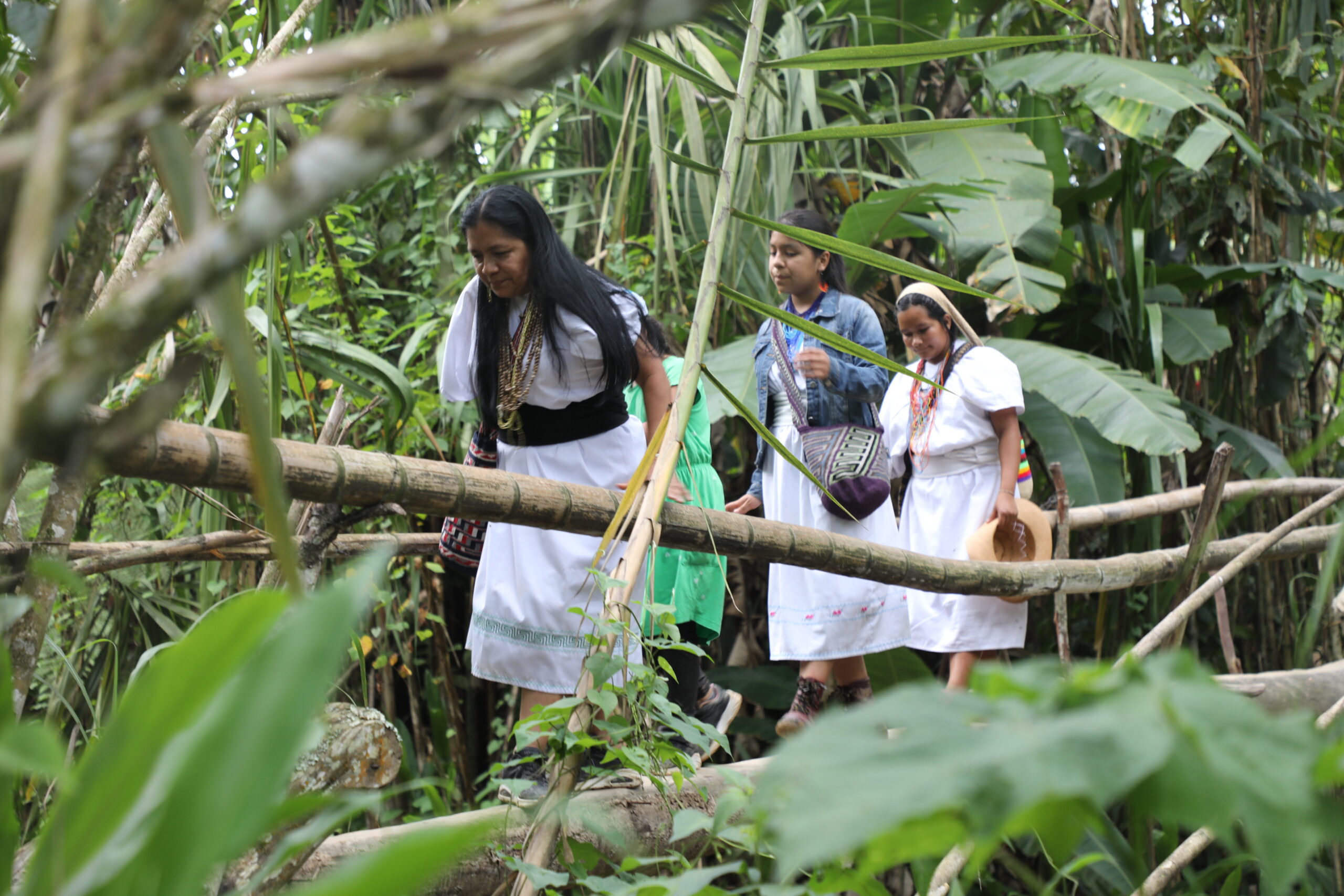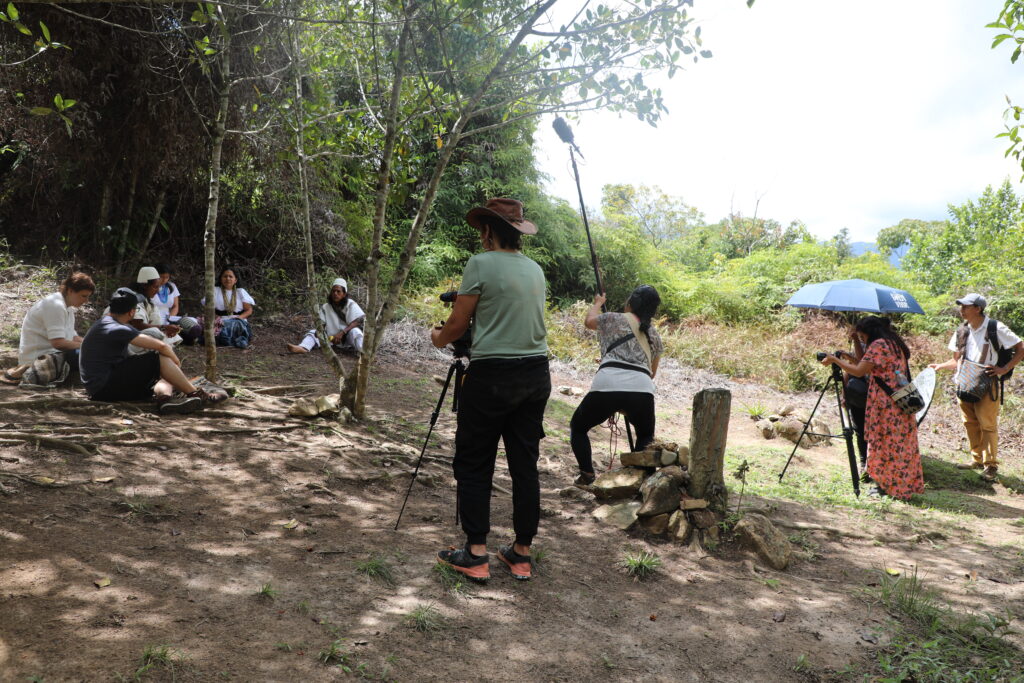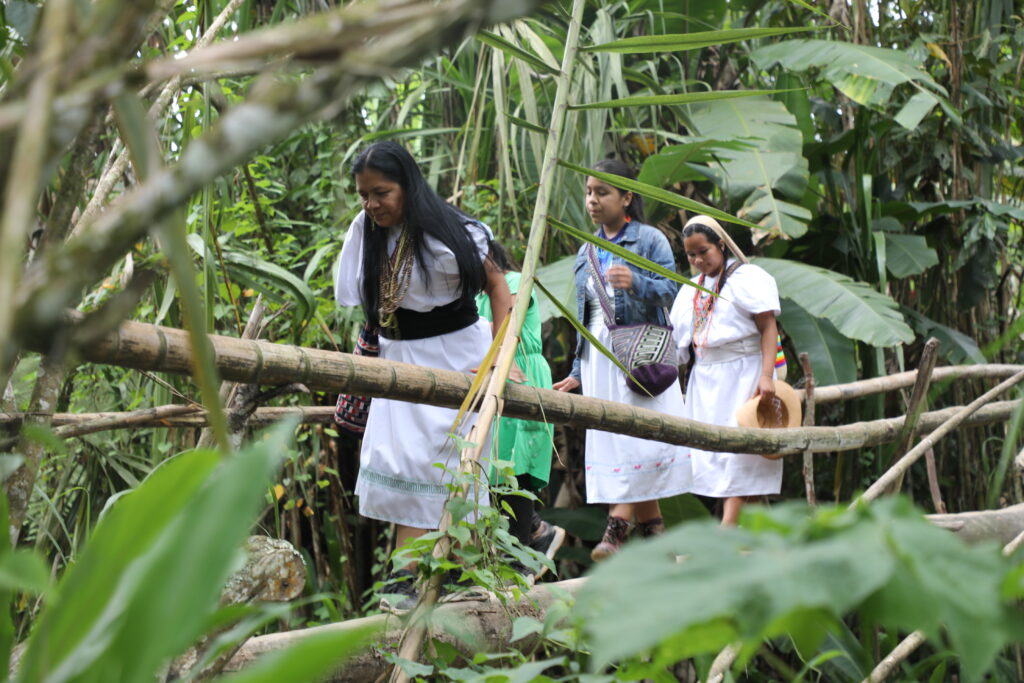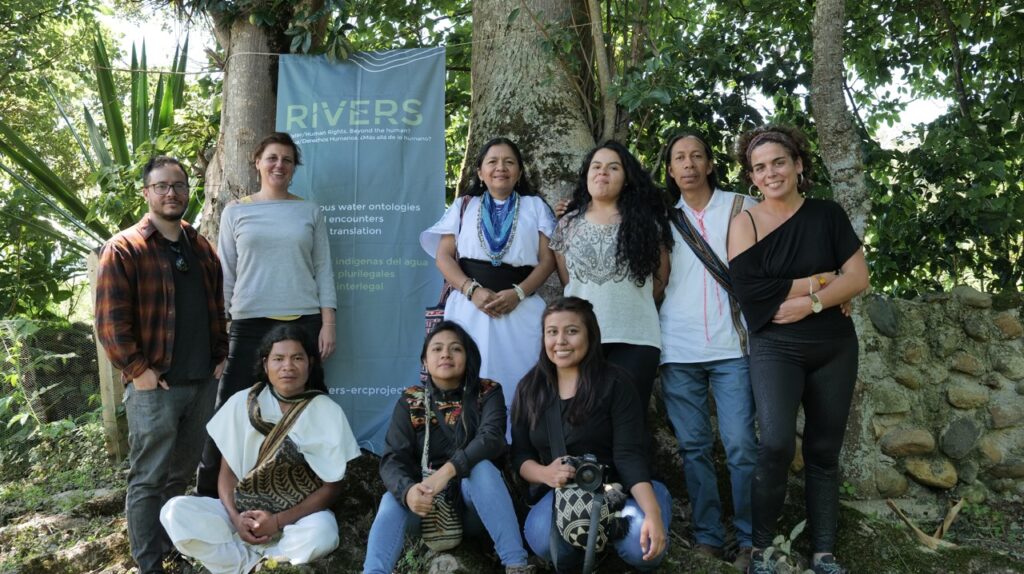
22 Mar “Mind your thoughts and words: you are in sacred territory.” A Chronicle of the pilot shooting experience of Rivers in Colombia, in June of 2023.
“Mind your thoughts and words: you are in sacred territory.” A Chronicle of the pilot shooting experience of Rivers in Colombia, in June of 2023.
In the Caduco, the Mamo awaits. After breakfast, we will go to see him, to ask for permission to film. In the lands of the Sierra Nevada de Santa Marta, Colombia, when the Bunachi arrive as guests, they must be patient and wait. It’s a matter of respect, of what must be done. It’s not common for a filming team to arrive in the lands of the Arhuaco People. It is not easy either to settle in and expect people to adjust to the timing and methods of traditional filming: although a common practice is to take advantage of every minute of day light to shoot as much as possible, if the Mamo does not give permission, nothing can be recorded. Beyond respecting the practices of the area, what is at stake is the intention in which we proceed. If we went to the “heart of the world” – as the Arhuacos call it – with the intention of documenting part of the important work that Judge Belkis Izquierdo is heading at the Special Jurisdiction for Peace (JEP), we must ask for permission and make the necessary “payments”, to connect with the “Spirit” of the place.
The shooting in Colombia was the pilot experience of the RIVERS project in the audiovisual field. In early June 2023, the RIVERS research team, Lieselotte Viaene and Diego Padilla, Colombian co-directors Rosaura Villanueva and Olowaili Green Santacruz, Catalan filmmaker Mariona Guiu, and Judge Izquierdo, gathered in the meeting room of a hotel in El Chapinero (Bogotá), to conclude the preparations for shooting.
In these sessions, we concluded the last details of the shooting plan: the outline and the shot list for a week and a half of fieldwork, with shots to be taken between Bogotá and the Arhuaco reserve in the Department of César, in the northeast part of the country. The objective: to film Judge Izquierdo in the offices of the JEP, then follow her on a scheduled trip to her hometown, to continue several unfinished conversations with the spiritual guides of the region.
The magistrate took advantage of her vacation to organize the trip and invited us to accompany her. In addition, she would take the opportunity to meet with Mamos and Akumamas from different locations in the reserve, visit relatives, and spend time with her children. True to her intercultural education, she decided to turn the trip into a learning experience for everyone. The journey would serve as a window into the Iku world, and at the same time, an exercise in the ongoing efforts to bridge the gap between worlds that she and others have undertaken, with the aim of finding common solutions to the current problems faced by Indigenous and non-Indigenous Peoples alike. The most immediate problem: the healing of the Territory.
The legal work carried out by the magistrate and her team involves investigating territorial “macro cases” of human rights violations committed during the internal armed conflict in Colombia. Having an Arhuaco woman leading the investigation has allowed for the introduction of a particular method into the prosecutors’ work that arises from the knowledge and feelings of the peoples, and leads to organizing measures to repair the damage caused to the Territory. These reparations must be made taking into account the ontologies of each community. Healing must be spiritual and not just material. Specifically, they must find ways to bring together the involved parts in the conflict and, with the intention of healing together, carry out “environmental” repair actions. This healing is closely related to the protection and care of sacred sites and spiritual governance, as they call it.
The Magistrate’s concerns precisely consider: How to heal together, and how to heal from a logic that goes beyond the human?
The first stop of the trip was at the Busintana botanical garden in Pueblo Bello. Busintana is a fifteen-hectare estate belonging to the Arhuacos, which serves as an ecological sanctuary, a center for Iku dialogue and conventions, and for sustainable production (panela, fertilizer). At the entrance, some of the guidelines for visitors go beyond what one commonly sees in ecological reserves. “Mind your vocabulary and thoughts… you are entering into a sacred space”.
Mamo Menjabin guides us to the entrance of the park, where the river flows. He welcomes us, we all introduce ourselves, and he grants us permission to film. That day we will witness a dialogue between Mamos and Akumamas and Belkis, inside a Kankurwa. But first, Belkis and her daughters explore the park, with the help of a young guide who introduces them to Iku practices and thoughts. In the Kankurwa, we discover that Belkis’s mission in life comes from birth. Her profession serves the Law of Origin. She is fulfilling a mandate that intimately connects her to the Arhuaco territory, to Mother Earth, and the community.
Topics such as the need to make payments, educate children, and recover the “natural order” arise in the conversation. Its recovery depends on the care and protection of sacred sites, and on the ritual practices through which they commonly consult the water, the hills, the stones, to deliberate.
The following day, we traveled to Yeurwa, a settlement located a couple of hours from Pueblo Bello, deep into the Sierra. The dirt roads began to get steeper and rougher. We crossed rivers and narrow passages until we reached Belkis’s birthplace.
Before starting the day’s work, we had to walk for two hours to reach the place where Mamo Kwaney Makú was waiting for us. Tensions rose within the team. We would arrive just before lunchtime, and valuable daylight hours would be lost where we could at least capture some footage (landscapes, people walking from one place to another…). Additionally, we debated among ourselves about the best way to request consent for filming. Besides obtaining permission from the Mamo, we needed to ask for oral or written consent to film voices and images. There was no agreement on the best time to do this. If we did it from the beginning, it could ruin the appearance of “naturalness” of the moment. If we did it at the end, people might leave without leaving their consent recorded.
At the end, Belkis set the guidelines. Upon arriving at the community center, she introduced us to the Mamo, she explained the purpose of the project, and gave us the floor to introduce ourselves. After hearing us talk about the project and what we wanted to do, the Mamo gave us his blessing, on behalf of himself and the collective. Belkis asked us, at that moment, to record the oral consent of the group. And so we did.
After lunch, before starting the dialogue, Belkis asked us to follow her. What was her intention? In the Caduco, it is important to keep this in mind. The Mamo leads us to an altar of small stones positioned on top of a rock, not far from the community center where we had lunch. Barefoot, we stand in front of the altar, next to Belkis and her family. Before starting the payment, the Mamo instructs us to make fists with our hands, as if we were tightly holding something invisible. In our fists, we must concentrate our thoughts, and then release them in the center of the altar, as if we were filling the stone containers with a handful of matter, one hand after the other. We repeat the process several times. My ankles pulse, swollen from the multiple mosquito bites.
The Mamo makes small knots on a long thread, tears it in small pieces, and distributes it among the group, one by one, hand by hand. First the right, then the left.
Belkis explains that in the thread we hold our intention in hand. When we are clear about our intention, we verbalize it and tie a knot. That intention is not immediately clarified. We listen to the Mamo’s prayers in Iku, we do not know what he is saying, the translator asks us to tighten and return the tied threads. He checks each knot and places each thread on the altar. This is how we make the intention real.
Author: Dwiawin Maku Zalabata / RIVERS ERC
The filming in Nabusímake was more challenging than we expected. Not everyone agreed to our presence there. It required negotiation on several occasions for us to be allowed entry and to have permission to film. Intracommunity politics were at play due to some internal tensions that we were unaware of. An unforeseen circumstance that could have led to an early end to the trip. Lieselotte and Belkis traveled to the village to speak with the Mamo and secure his support. Meanwhile, the team waited in the visiting cabins managed by one of Belkis’s relatives. It was agreed that we would be allowed to film, as long as drones did not fly over the historic village.
The team captured various B-roll shots and more conceptual shots, such as close-ups of Belkis’s body or other shots of her lying down, aiming to represent the intimate connection between the territory and the body. Things that are not easily dissociable for the Arhuacos.
An hour before sunset, we gathered to listen to the last Mamo of the trip, Mamo Enrique Izquierdo. We discussed self-government. The care of Mother Earth has to do with recognizing that the spirit is being lost nowadays, and the spirit is connected to all living beings; its health is the health of all, and all things at once… “that’s why the elder Mamos always said that the day the flows start to decrease, or the melting of the snow-capped mountains, with it, the spirit of being will begin to diminish (Mamo Enrique Izquierdo)”.
And what can be done in that case? Mamo Enrique insists that there is work that they themselves must do, so that the youth keeps the Law of Origin alive. They must keep the payment alive and act accordingly. Belkis insists on a common healing with the Bunachi, in opening the way to share this task. This is a work in progress.
At the end of the conversation, the Mamo asks us to verbalize our intention out loud. Everyone speaks from the heart. The Mamo takes the threads that we held in our hands all that time and ties them to our wrists. So as not to forget the commitment made on the journey. The filming ceased to be a simple documentation and communication job. Now, we are committed to communicating the message of the Arhuaco People from a different logic.
Belkis wondered in one of the conversations: How to send a message to the world that manages to reach people’s hearts, a message beyond rationality? “What the Mamos and Akumamas say is that the territory is alive, that the places speak to us… we must open up the thought that there are different ways of feeling, of understanding… for there to be healing (Belkis Izquierdo)”.
Que así sea.
Author: Mariona Guiu / RIVERS ERC
ABOUT THE AUTHOR
Diego Padilla – RIVERS Coordinator/Producer of the Documentary Project (Universidad Carlos III de Madrid)






